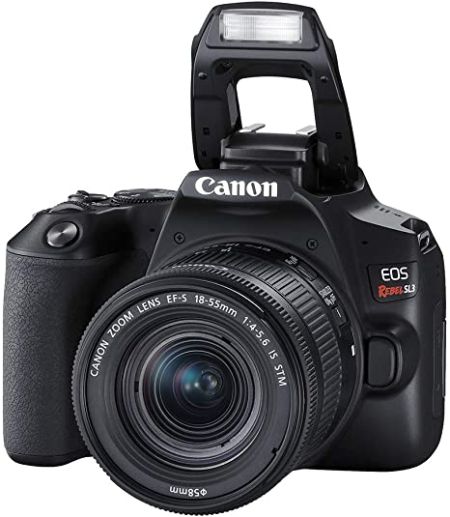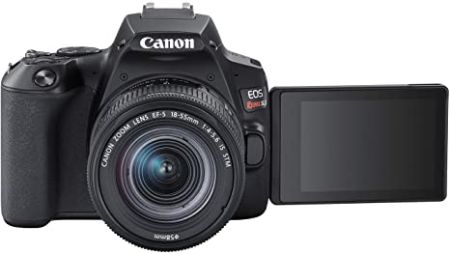The SL3 is one of the littlest SLRs you can purchase, however, it’s as yet an SLR. It measures 3.7 by 4.8 by 2.8 inches (HWD) and weighs 15.8 ounces without a focal point connected. It’s somewhat more modest all around than the Nikon D3500 (3.9 by 4.9 by 2.8 inches, 12.9 ounces), however greater than a commonplace mirrorless camera, similar to Canon’s EOS M50 (3.5 by 4.6 by 2.3 inches, 13.8 ounces).
the Rebel SL3, otherwise called the EOS 250D and EOS 200D II, followed on from the entirely competent EOS Rebel SL2/EOS 200D that surfaced two years before it and effectively advanced onto our best DSLR camera list.
At the hour of delivery, a large part of the Rebel SL3’s center list of capabilities was recognizable to us, yet it likewise denoted the presence of a 4K video on a DSLR this modest from any maker.
Features
The SL3 is sufficiently little so practically its actual controls are all situated on the right half of the body. The exemption, Menu, and Info buttons sit at the upper left corner of the back plate, over the LCD, and to one side of the eyecup.
The vast majority of Canon‘s DSLRs are fitted with 24MP APS-C sensors, and the EOS Rebel SL3 is the most recent beneficiary. This is accepted to be the very sensor that was featured in the past Rebel SL2, and it likewise includes a comparative Dual Pixel CMOS AF framework incorporated into it.

This framework involves pixels in the sensor to perform stage distinguish AF, which is how DSLRs typically center when you utilize the viewfinder. Having this on the sensor permits the Rebel SL3 to concentrate rapidly while utilizing live view or while catching recordings – something we’ll investigate in more profundity later.
The camera is fitted with a similar EF mount that has long served Canon‘s EOS DSLRs, and this acknowledges both EF-S and EF focal points. Whichever sort of optic you pick, the size of the camera’s sensor implies your focal point is dependent upon a 1.6x yield factor.
Thus, the EF-S 18-55mm f/4-5.6 IS STM focal point that is the default pack choice with the camera gives a powerful central length of around 29-88mm. Focal points with their Image Stabilizer (I.S.) frameworks are especially advantageous here, given the absence of an identical sensor-based framework inside the actual camera.
The camera can fire eruptions of pictures at 5fps, which is unaltered from the Rebel SL2, notwithstanding the presence of the more current DIGIC handling motor. This burst rate is genuinely decent for section-level models, yet is very obsolete contrasted with numerous mirrorless models.
Assuming you are someone that likes to shoot activities and additionally moving subjects, it probably won’t be the right model for you. The better news is that the Digic motor does, notwithstanding, support a 4K video catch to 24p, although there are various limitations.
Recordings are likewise dependent upon a yield factor, and that implies you lose a tad bit of the wide-point perspective on your focal points when you begin recording, albeit this isn’t an issue while recording Full HD or Standard HD recordings. You likewise can’t utilize the Dual Pixel CMOS AF framework, except if you’re glad to wreck the goal to Full HD.
Connectivity and Power
The SL3 incorporates Bluetooth and Wi-Fi and works with Android and iOS telephones and tablets through the Canon camera associate application. The Bluetooth association speeds up the matching system, and Wi-Fi permits you to move photographs and recordings to your telephone or to involve it as a controller.
There are 2.5mm remote and 3.5mm receiver ports on the left half of the body. The miniature USB and little HDMI connectors are on the right side. The battery and memory card load in the base; in-camera charging isn’t upheld, so Canon incorporates a wall charger.

The battery is appraised for around 1,070 shots utilizing the optical locater or around 320 utilizing live view in light of CIPA testing guidelines. Battery duration is one region where SLRs enjoy an upper hand over mirrorless cameras, essentially while looking for models in this cost class.
The SL3’s solid battery duration unquestionably makes the oversight of in-camera charging to a lesser extent a certifiable concern.
The memory card opening backings SD, SDHC, and SDXC cards at up to UHS-I speeds. It doesn’t exploit the most recent UHS-II cards, however, it doesn’t shoot quickly enough for it to be a restricting variable.
Structure and Build-in
Group charges the EOS Rebel SL3/EOS 250D just like its littlest and lightest DSLR. It’s its joint-littlest – the 122.4 x 92.6 x 69.8mm aspects are unequivocally equivalent to the Rebel SL2’s – while the dark choice weighs 4g not exactly the dark Rebel SL2 at 449g, and the white choice is 5g lighter than the white SL2 at 451g, these estimations are including the battery and card.
Nikon figures out how to beat this with its D3500 model, which weighs 415g, although, as Canon brings up, the Rebel SL3 is the lightest DSLR with a mobile LCD screen. Regardless, such a little contrast ought not to be a huge issue; it’s little, light, and no irritation to haul around for broadened timeframes.
The Rebel SL3’s body follows a lot of a similar plan as the Rebel SL2, even though Canon has made various little changes. The SL3 loses a portion of the SL2’s bends and embraces a more precise style, while a portion of the controls has been unpretentiously restyled.

The profundity of the field the review button has been dropped from the front plate, as has the blaze button; to raise the glimmer you presently pull it upwards from one of the sections to its sides.
The WiFi button that adorned the Rebel SL2’s top plate was also separate, as was Creative Auto’s choice of the mode dial. This all makes for a less complex plan, although it doesn’t be guaranteed to feel like a positive development regarding convenience and activity.
On the hand, the EOS Rebel SL3 finds some kind of harmony between compactness, activity, and general dealing. While the body is tiny, the hold is just about sufficient to fit pleasantly into the normal estimated hand, and the thumb rest likewise has barely adequate room for the normally measured thumb to sit easily.
Elastic is just utilized for the vital pieces of the body, which for this situation are the hold and thumb rest, yet this further develops taking care of. The remainder of the body has a smooth packaging and construct quality seems to measure up to assumptions; it presumably won’t self-destruct from general use, however, it probably won’t take a thump like a camera with magnesium or aluminum compound utilized in its external boards would.
Self-adjust and Burst Shooting
The SL3 powers on, centers, and catch a picture in about a half-second, a lot of speed to snatch a real shot. In splendid light the center rushes to lock onto a static subject, doing so and catching a photograph in under 0.05-second.
In extremely faint light the center time expands, expecting around 0.3-second to seize center with the pack focal point, which is good enough for a section level SLR.
Live View center is a serious area of strength for a. The SL3 involves a similar Dual Pixel AF framework as Canon’s mirrorless models, which has an observable presentation advantage over the unadulterated difference frameworks utilized by contending models from Nikon like the D5600.
In brilliant light the camera rushes to secure concentration in Live View for all intents and purposes with the optical locater, however, it scored a 0.5-second postpone in extremely faint circumstances.
Continuing to move subjects in a fresh center is another matter. It’s a region where the SL3 doesn’t stay aware of the marginally bigger Rebel T7i. The SL3’s self-adjust framework is extremely essential, with nine selectable places, gathered covering around 33% of the sensor region.
The oversimplified center framework is something restricting the burst speed. The camera oversees 5fps with a fixed center and can catch up to 13 shots before it dials back when Raw is turned on. If you’re shooting in JPG the SL3 can shoot persistently at 5fps.
It eases back marginally while working in AI Servo — Canon’s name for nonstop concentration. The 4.6fps rate is relatively close to the most extreme 5fps rate, yet it floundered a piece with regards to precision.
The SL3 conveys a hodgepodge, going from entirely sharp to somewhat out of concentration to obscured.
Imaging and Video
The SL3 offers up no curve balls with regards to picture quality. It involves a similar sensor and picture processor as the EOS M50, and the package 18-55mm zoom is similar to one Canon included with the SL2.
Imatest shows that the camera holds commotion under 1.5 percent while catching JPGs through ISO 6400. Quality misfortune sets in somewhat prior, with extremely slight smearing apparent at ISO 800 and 1600. Picture quality makes a stride back at ISO 3200, with some haze observable there through ISO 12800. The haze is more grounded at the top ISO 25600 and 51200 settings.
Cost
Group sells the SL3 as a body just for around $600 or packaged with the EF-S 18-55mm f/4-5.6 IS STM for $749. If you purchase the camera with the kitted focal point you can choose a dark or white variant, however, if you need to get the body without anyone else you’ll have to get it in dark.
A disgrace Canon’s littlest, most economical EF-S focal point, the $150 24mm f/2.8 STM, isn’t sold in that frame of mind with the camera. It appears to be an ideal fit, and ought to be a focal point you ponder adding to the SL3 (or another Canon SLR, if you need a little, economical prime).
Final Thoughts
If you’re looking for a top-notch, highly functional mirrorless camera, there are plenty of other options out there that can get the job done without costing as much. If you’re comfortable making the investment in Canon lenses, and your budget is big enough to allow for it, we think you’ll be happy with the EOS Rebel SL3.
If you’re looking for an entry-level DSLR to get yourself into photography and videography, the Rebel SL3 is a great place to start. Its size and weight make it easy to carry around all day, so you can capture those spontaneous moments without being burdened by what you have to carry.









